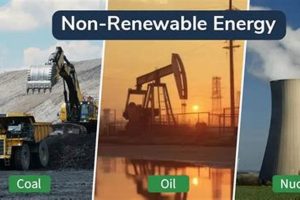
Finite resources, formed from organic matter over millions of years, are the source of energy classified as non-renewable. Fossil fuels, such as coal, oil, and natural gas, are prime examples. These resources... Read more »

Comparing energy generation methods requires an assessment of how effectively they convert available resources into usable power. For example, a solar panel’s effectiveness is measured by how much sunlight it transforms into... Read more »

Protecting natural resources through mindful consumption and efficiency improvements is crucial for environmental sustainability. Coupled with this, harnessing power from sources that naturally replenish themselves, like sunlight, wind, and water, offers a... Read more »

A naturally occurring hydrocarbon gas mixture consisting primarily of methane, this energy source is categorized as a finite resource due to its formation process over millions of years. Extracted from underground reservoirs,... Read more »

Sustainable power generated from natural resources like solar, wind, hydro, and geothermal sources offers a cleaner alternative to conventional fossil fuels. For instance, a community might harness the power of a nearby... Read more »

A significant consideration within global energy discussions centers on the proportion of total power generated utilizing naturally replenishing resources. This quantity reflects the degree to which societies are moving away from finite... Read more »

The global energy landscape is shaped by the interplay of various energy production methods, broadly categorized as renewable and non-renewable. Renewable sources replenish naturally over relatively short periods, while non-renewable sources exist... Read more »

Assessments designed to evaluate comprehension of sustainable and finite power generation methods typically encompass various question formats, such as multiple-choice, true/false, and matching. These evaluations can cover topics ranging from specific resource... Read more »

ExxonMobil’s engagement with alternative energy sources encompasses research and development, alongside limited investments in biofuels and carbon capture technologies. For example, the company has explored algae-based biofuels and invested in companies developing... Read more »



